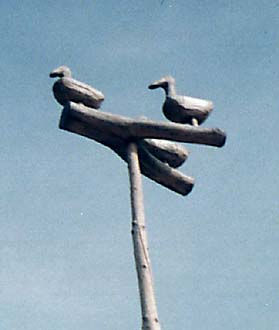

|
Three ducks on a tall pole just outside of Kangnung (Gangneung)? What's the meaning of this? Back in 2000, when Margaret first snail-mailed this picture home, I started looking for an explanation. Somewhere on the web, I found a source (which I've long since lost track of) that told me they were jintobaegi. It said they "connect the people with the heavens, and the earth with the sky." Well, now, that's a pretty flowery phrase, the sort that I tend to enclose in big quotation marks because, while it's an earnest effort at a one-sentence summary, it doesn't quite satisfy. The problem is that they're trying to find Western English words for decidedly non-Western and non-English feelings and attitudes. We just don't have the vocabulary or the background. We're missing that 5,000 year history and the Shamanic religious roots. There just isn't a one-sentence answer to what these ducks stand for. First you have to understand that Korea's ancient religions involved sun gods, moon gods, earth gods, mountain gods, and even animal gods such as dragons and horses. These gods seem to have been associated with the forces that made life possible, such as light and water. Others became linked to protection against things that threatened life, such as fire and wild animals (especially tigers, which are the bad guys in many ancient Korean folk tales). Totems like this were part of the mix. They were visible objects that stood for invisible gods, things that people could pray to in the hope of reinforcing the good things and avoiding the bad. My first source was right. The ones near Kangnung are indeed called jintobaegi (also Anglicized as Chinttobaegi). One thing it didn't mention is that in other parts of Korea they're known as sottae or chimdae. Sottae usually have a bird or three, sometimes wood and sometimes stone, at the top of the pole. Like all good totems, jintobaegi and sottae fairly reek of symbolism. The pole itself stands for a snake or a dragon, which is supposed to bring rain for the farmers. Sometimes the poles are even carved with snake or dragon patterns. The ducks on Kangnung's represent water, pretty much a winner for the whole village. The farmers get a double play here because, like the pole itself, the ducks mean rain for their crops. The fishermen get a good catch, though it's not quite clear to me how this symbolism works. Everybody else gets protection from fire. (Somehow I think a bucket brigade would have been more effective, but who am I to say?) I don't doubt there are some Korean who still believe in these things, or at least go through the motions. After all, some of them still go to fortune tellers to find out the best time to get married, or visit a Shamanic priestess to reverse a string of bad luck. But from what I can tell, these days the worship rituals with these totems are done mostly as part of a folk re-creation (also see Kangnung Tano, these days called Gangneung Dano, thanks to the new Romanization scheme). |